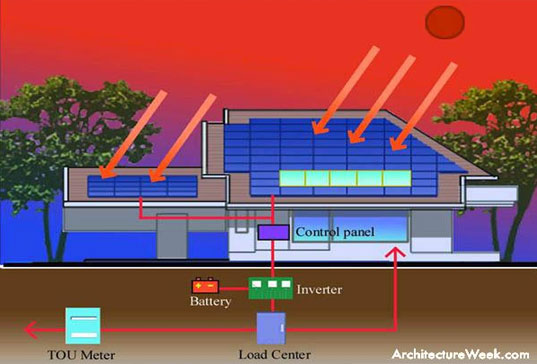This Bio-Solar home of Soontorn Booyantikam can harvest 20 to 25 gallons of water per day, the air conditioning produces 8 gallons of condensation. Rain and dew also do not go to waste and gets collected from the roof, the amount varies from season to season.
How and Why: Bio-solar House
Chris Lundahl
The biggest goals in the construction industry today is to build houses that have a minimum carbon footprint, offer a healthy environment for its owner, that is energy-efficient and that is sustainable. Every now and then there are new materials, technology and methods making these goals more possible.

Imagine having a self-reliant house that can make its own electricity and water. Electricity for air-conditioning, lights, and other appliances gets provided through solar energy. The house can produce its own water for the whole family through a rain, dow, and condensation cooling system. Recycled water irrigates the garden and excess electricity can be used to drive an electric car every day or can be sold to a power company. Amazing, isn't it? That is all possible when you have a Bio-solar home. Investing into a Bio-Solar house might be costly when you compare it with a conventional home but think of how much you would be able to save if you never have to pay another utility bill ever again.
The designer of such a Bio-solar home is the architect Soontorn Boonyatikam, who built his own Bio-solar home for him and his family in Bangkok. Besides his interest in sustainable design, he got motivated to do this project because of his wife's allergies to the polluted Bongkok air, making it his goal to isolate a home that would not be affected by pollution. Another motivation was never wanting to pay another energy bill as he reaches his retirement.
This Bio-Solar home of Soontorn Booyantikam can harvest 20 to 25 gallons of water per day, the air conditioning produces 8 gallons of condensation. Rain and dew also do not go to waste and gets collected from the roof, the amount varies from season to season. The tank capacity is 950 gallons that will store this harvest water after it has been filtered. All the water that runs down the drain from the kitchen, shower, carport and washing machine also gets filtered and reused for irrigation. The solar cells and energy storing system can store energy for three days.
Besides the ability of the house to harvest water and electricity, the real magic behind the construction of the house is to do with the insulation and ventilation function of the house. The roof made of metal absorbs most of the heat. The heat that gets absorbed by the roof gets ventilated by an air duct, found between the thick insulation of 30cm and the roof of the house. Not to worry if the wind is not blowing in your favor because the garden takes care of that, as the garden has several artificial mounts which are designed to direct the wind towards the house. The triple-paned (heat-stop) window prevents the sun from shining directly into most of the interior in order to reduce heat gain. A bio-solar house like this is up to 14 times more energy-efficient than a conventional house.
According to Architect Soontorn Booyantikam, to build an airtight house like this you need a high degree of workmanship which is something that Klaus Becher, the inventor of the Bio-Solar Passive houses was able to master. These Passive houses are prefabricated and even though they might not be as unique as the bio-solar house of Mr. Soontorn, they function as a Bio-solar home. The main focus is to bring an airtight, sustainable, energy-sufficient home with a clean and pleasant interior to your land.
About Chris Lundahl
Chris Lundahl is a home improvement writer and editor for Arizona Roofing Systems, Mesa.
The content & opinions in this article are the author’s and do not necessarily represent the views of AltEnergyMag
Comments (0)
This post does not have any comments. Be the first to leave a comment below.
